- Home
- Lynne Olson
Those Angry Days Page 2
Those Angry Days Read online
Page 2
The president, meanwhile, was hardly a passive bystander in the struggle. In September 1939, he told an associate that it was going to be “a dirty fight.” His prediction was accurate, of course, and he played a major role in making it so. Convinced that the isolationists, particularly Lindbergh, posed a major threat to the country and himself, Roosevelt and his supporters, assisted by a covert British intelligence operation, embarked on a campaign to destroy their credibility, influence, and reputations. As part of that effort, FDR authorized FBI investigations of his political opponents, who were branded by administration spokesmen and much of the press as subversives, fifth columnists, and even Nazis. In return, his foes portrayed Roosevelt as a dictator who had destroyed free speech in America and was rushing it into war without the consent of the people. According to Lindbergh, democracy “doesn’t exist today, even in our own country.”
That image of the president as a sinister “super-Machiavelli,” intent on ramrodding America into the conflict by insidious and unlawful means, doesn’t hold up. But neither does the more beneficent idea, put forward by many historians, that Roosevelt, knowing full well that America must enter the war but hamstrung by strong isolationist public opinion until Pearl Harbor, had no alternative but to edge the country toward intervention by indirect and often devious methods.
In fact, by December 1941, the American people had been thoroughly educated about the pros and cons of their country’s entry into the conflict and were far less opposed to the idea of going to war than conventional wisdom has it. And it’s far from clear that Roosevelt himself, while certainly determined to help Britain, ever intended that America go to war, at least in the sense of sending troops. Indeed, there is ample evidence, as the historians William Langer and S. Everett Gleason noted, that the president “recoiled from the prospect of war, was determined to spare no effort to keep this nation out of it, and devoutly hoped that, by one means or another, he would succeed.”
Although FDR exhibited bold leadership in the first years of his presidency and again after America was catapulted into the war, he was notably cautious and hesitant in the two years before the Japanese attack on American soil. Eloquent and forceful in his repeated calls for action to help Britain and end German aggression, he often procrastinated in making such action a reality. He was intimidated by congressional isolationists, whose strength he tended to exaggerate, and was loath to challenge them.
George Marshall later remarked that from 1939 to 1941, he had doubted the president’s ability to lead America in a national emergency. Observing FDR’s swift, decisive actions following Pearl Harbor, Marshall finally concluded that his commander in chief was in fact a great leader. “I hadn’t thought so before,” the Army chief of staff said. “He wasn’t always clear cut in his decisions. He could be swayed.”
This vacuum of leadership at the top was filled, to a large extent, by several private citizens’ groups, which mounted campaigns—some of them quietly encouraged by the president—to educate and mobilize American public opinion in favor of intervention. The work of these organizations, according to one prominent interventionist, allowed Roosevelt to “move gingerly in the direction of saving his sleeping country.”
One of the most striking—and unsung—aspects of the fight over U.S. involvement in the war is the critical role played by ordinary Americans in its development and outcome. Millions of individuals, convinced that the survival of their country was at stake, became involved in the debate, which, for all its anger and mudslinging, was a true exercise in democracy. Grassroots activism flourished throughout the nation as volunteers on both sides circulated petitions, phoned their neighbors, ran ads, and lobbied their congressmen.
These citizens’ movements would have a considerable impact on U.S. foreign policy and ultimately on the course of the war itself. At Yale, antiwar college students—among them a future U.S. president, the first head of the Peace Corps, and a Supreme Court justice—founded the America First Committee, which would fast become the nation’s most influential isolationist organization. Interventionist groups, for their part, played a critical role in the administration’s controversial decision to send fifty old destroyers to Britain in exchange for the lease to America of British bases in the Western Hemisphere. Interventionists also helped persuade Roosevelt to make fateful changes in his cabinet, and they were the chief force in persuading a highly dubious Congress in the summer of 1940 to approve the first peacetime draft.
Two months before the draft bill was passed, a coalition of political amateurs hijacked the largely isolationist Republican Party and, at one of the most exciting conventions in American history, engineered the presidential nomination of Wendell Willkie, a dark-horse interventionist who had announced his candidacy only seven weeks before. Although Willkie would turn out to be the strongest opponent FDR ever faced in his political career, the president called the Republican’s nomination a “godsend for the country” because it removed the war as a campaign issue and signaled to the world that America’s top political leaders stood together against Axis aggression.
Thanks in large part to these efforts by private citizens, the American people were made aware of the need to ready themselves, both militarily and psychologically, for the looming war. By the time of Pearl Harbor, attitudes toward entering the war had shifted dramatically. According to polls, a substantial majority of the U.S. population now regarded “defeating Nazism” as “the biggest job facing their country”; a similar majority preferred U.S. entry into the war to a German victory over Britain.
After all the bitter conflict of the previous two years, America was finally ready to claim its future.
CHAPTER 1
“A MODERN GALAHAD”
The cab stopped in front of the Smithsonian’s Arts and Industries Building and Charles Lindbergh stepped out. He stared for a moment at the Victorian-era museum, with its turrets and multicolored brick facade, then strolled around its perimeter, hoping to find a side door. Seeing none, he returned to the front entrance, considering how to slip past the tourists outside without being recognized.
By now, avoiding public attention was as natural to Lindbergh as breathing. He put his head down, covered his nose with a handkerchief, blew into it—and walked into the museum unnoticed. Once inside, he ducked into the first room on the right, which featured a display of dresses worn by the nation’s First Ladies, and stationed himself by the salmon-pink silk gown that once belonged to Martha Washington. From there he had a perfect view of the Spirit of St. Louis, hanging from the ceiling in the main hall.
It was March 1940, and Europe was at war. Lindbergh was at the epicenter of the struggle over America’s role in the conflict. But for almost an hour that day, he took time out from the frenzy of the present to find refuge in the past. Lost in reverie, the lanky blond aviator gazed at the Spirit of St. Louis, suspended by cables above the tourists staring up at it. He had long felt a mystical closeness to this tiny silver plane. When he landed in Paris on May 21, 1927, at the end of the first solo transatlantic flight in history, his first thought had been how to protect it from the hordes of frenzied Frenchmen racing across the field to greet him.
To Lindbergh, the Spirit was “a living creature,” with whom he had shared a transcendent experience and whose loyalty to him was unquestioned. In his mind, they were inseparably linked: he always referred to the plane and himself as “we.” (Indeed, We was the title of the first of two books he wrote about the flight.) More than once in recent years, he dreamed he had crept into the Smithsonian at night, cut the Spirit down, transported it to an airstrip, and taken off. Once aloft—away from his troubled, complicated life—he experienced nothing but joy. He could ride the sky “like a god … I could dive at a peak; I could touch a cloud; I could climb far above them all. This hour was mine, free of the earth.”
A supremely rational, practical man by nature, he was unexpectedly lyrical, even fanciful, when he later described his visit to the Smithsonian in his journal
. He noted the kinship he felt with the mannequin representing Martha Washington as they studied the Spirit together: “I rather envied her the constant intimacy with the plane that I once had.”
But then, he wrote, he suddenly noticed two young women staring at him. He was well acquainted with that look. Not quite certain it was him, they soon would come closer to find out. Up to that point, it had been a wonderful visit: just him, Martha, and the Spirit of St. Louis. Determined to preserve the enchantment of the moment, he spun around and walked out.
WHEN THE TWENTY-FIVE-YEAR-OLD Lindbergh touched down at Paris’s Le Bourget airfield on that late spring evening in 1927, there was so much awaiting him, his wife later observed: “Fame—Opportunity—Wealth, and also tragedy & loneliness & frustration.… And he so innocent & unaware.” Several decades after the flight, the Lindberghs’ daughter Reeve mused: “Sometimes … I wonder whether he would have turned back if he’d known the life he was headed for.”
Although his flight had attracted considerable attention even before he’d taken off, Lindbergh was convinced that any fame that followed would swiftly vanish. Soon after he arrived in France, he presented letters of introduction to Myron Herrick, the U.S. ambassador, unsure whether Herrick even knew who he was. He had no inkling of the remarkable international response to what had been, in essence, a stunt flight—a stunt that the press and public, especially in America, had transformed into something infinitely more.
Charles Lindbergh and the Spirit of St. Louis.
The New York Evening World, for example, had made the astonishing declaration that Lindbergh had performed “the greatest feat of a solitary man in the records of the human race.” The day after the flight, the usually staid New York Times, under the banner headline LINDBERGH DOES IT!, devoted its entire front page and four more pages inside to stories about the young airman and his triumph.
In hindsight, the reason for the extraordinary reaction was clear: America, nearing the end of a decade marked by cynicism, disillusionment, and political apathy, badly needed a hero. As one historian put it, Lindbergh became “a modern Galahad for a generation which had forsworn Galahads.”
The 1920s in America had been a feverish time, noted for government corruption and graft, a spectacular boom in the stock market, organized crime on an unprecedented scale, a widespread rebellion against convention, the loss of idealism, and an emphasis on enjoying oneself. All this was fodder for the country’s booming mass-circulation tabloid newspapers, which specialized in prodigious coverage of the latest national sensation, be it a murder trial, a heavyweight boxing match, or a dramatic but failed attempt to rescue a man lost in a Kentucky cave. Under heavy competitive pressure, the other, more respectable newspapers more often than not followed the tabloids’ lead, as did the national magazines and a mass media newcomer called radio.
In early 1927, the media, insatiable as ever, had shifted their focus to the $25,000 prize offered by Raymond Orteig, a wealthy French-born businessman living in Manhattan, to whoever made the first nonstop flight from New York to Paris (or vice versa). Although several airmen had already failed—and died—in the attempt, a new crop of aviators had recently announced plans to enter the competition. Most were well known, with expensive, technologically advanced planes, considerable outside financial backing, and armies of assistants, including staffers whose sole job was to publicize their bosses’ participation. And then there was Charles Lindbergh, an unknown, virtually penniless airmail pilot from Minnesota who managed to scrounge just enough funds from a group of St. Louis businessmen to finance the construction of a stripped-down little plane he named Spirit of St. Louis, in honor of his benefactors.
To aviation experts, Lindbergh’s plan appeared more than quixotic; it seemed suicidal. Never having flown over any large body of water before, he would now try to cross the Atlantic, steering by the stars, a method of navigation relatively unfamiliar to him. He would carry neither parachute nor radio. Even more foolhardy, he planned to make the thirty-three-plus-hour flight alone. No one had ever attempted such a hazardous journey solo; as one wit noted, not even Columbus had sailed by himself. Lloyd’s of London, which issued odds on virtually any enterprise, regardless of its danger, refused to do so for Lindbergh’s venture. “The underwriters believe the risk is too great,” a Lloyd’s spokesman declared.
America has always loved an underdog, especially one as polite, unassuming, self-disciplined, and boyishly handsome as Lindbergh—a stark contrast to the bootleggers, gangsters, playboys, arrogant bankers, dizzy flappers, and corrupt government officials who made up a sizable percentage of the era’s top newsmakers. It was not surprising, then, that when he took off from Long Island’s rain-slick Roosevelt Field in the early morning of May 20, 1927, the entire nation anxiously followed his progress. Newspapers throughout the country printed extra editions, and radio broadcasts issued frequent flash bulletins. During a prizefight at Yankee Stadium, forty thousand people, at the urging of the announcer, rose as one and prayed silently for the young flier. In his May 21 newspaper column, the humorist Will Rogers wrote: “No attempt at jokes today. A slim, tall, bashful, smiling American boy is somewhere over the middle of the Atlantic Ocean, where no lone human being has ever ventured before.”
When word came that Lindbergh had made it, America went mad. “We measure heroes as we do ships, by their displacement,” said Charles Evans Hughes, soon to be chief justice of the U.S. Supreme Court. “Colonel Lindbergh has displaced everything.” President Coolidge dispatched an admiral’s flagship to Europe to bring Lindbergh and the Spirit home. In Washington, the president presented him with the Congressional Medal of Honor and Distinguished Flying Cross. In New York, more than four million people—75 percent of the city’s population—lined its streets to honor Lindbergh in the biggest ticker-tape parade in New York’s history. A few months later, Time magazine named him its first “Man of the Year.”
After his tumultuous homecoming, Lindbergh spent three months touring all forty-eight states in the Spirit. An estimated thirty million people flocked to see this new national idol, labeled a “demigod” by one newspaperman; wherever he appeared, huge crowds fought to get near him. Intensely uncomfortable with the adulation, Lindbergh sought to use his fame to increase public interest in commercial aviation. Instead of accepting the millions of dollars he was offered to endorse products or appear in movies, he became a technical adviser to two start-up airlines—Pan American Airways and TAT, which eventually became Transcontinental and Western Air and ultimately Trans World Airlines (TWA). Working with both to help establish passenger service, he flew all over the country and later the world, surveying possible air routes, testing planes, and playing a key role in creating the first modern airports.
Try as he might, however, this intensely reserved, solitary man was unable to reclaim his privacy and restore equilibrium to his life. His engaging modesty, coupled with his refusal to capitalize financially on his celebrity, only whetted his countrymen’s appetite for more information about him. “In his flight, and even more in his fame, he proved that personal heroism, decency, and dignity were yet possible in the world,” wrote Kenneth S. Davis, a Lindbergh biographer. Americans were in no mood to leave such a paragon alone, and neither was the press.
Wherever he went, he was besieged. Strangers came up to him to shake his hand or pat him on the back, women tried to kiss him, crowds gathered in hotel lobbies and outside restaurants, waiting for him to appear. At a picnic he attended with members of his National Guard unit in St. Louis, he watched with disgust as several young women crept under a restraining rope to grab corncobs he had just chewed on.
The furor only increased when, in May 1929, he married Anne Morrow, the shy, pretty twenty-two-year-old daughter of the U.S. ambassador to Mexico. The Lindberghs were stalked everywhere by the public and press, even on their boating honeymoon off the coast of Maine, where they were followed by motor launches filled with reporters and photographers. “Like criminals or illicit lover
s, we avoided being seen in the world together,” Anne Lindbergh later wrote, “and had to forgo the everyday pleasures of walking along streets, shopping, sightseeing, eating out at restaurants.”
A loner all his life, Lindbergh was singularly unprepared for all this. The only child of a small-town Minnesota lawyer and his schoolteacher wife, he had lived an isolated, rootless existence since early childhood. When he was four, his father, a stern man with a strong populist bent, was elected to Congress, and for the next ten years, Charles shuttled back and forth between Washington and the family farm near Little Falls, Minnesota.
His parents had an extremely unhappy marriage, punctuated by violent quarrels, and Charles responded by rigidly controlling his emotions and withdrawing into his own solitary world. In school, he had virtually no friends, took part in no sports or extracurricular activities, was silent in class, and did not date. After his flight to Paris, his high school classmates, when questioned by reporters, had few if any memories of him.
As an acquaintance of Lindbergh’s later put it, his historic achievement and its aftermath plunged him “into waters that he did not understand and could not navigate.” He adamantly resisted the idea that he and his wife were public property. While he readily answered queries from reporters about his flights and aviation in general, he curtly turned aside any questions about his personal life and refused to sign autographs or pose for photos. His recalcitrance only fanned the publicity flames. “Because he kept a distance,” Time noted, “the public became more hysterical.”
Anne Morrow Lindbergh with her newborn son, Charles Jr., who was kidnapped and killed in March 1932.
As a result, the Lindberghs lived under constant siege at their secluded home, set in several acres of woods near Hopewell, New Jersey. Tabloid reporters went through the Lindberghs’ garbage, pilfered their mail, and offered bribes to their servants for tidbits about their private lives. One journalist even applied for a servant’s job with the couple, presenting them with forged references.

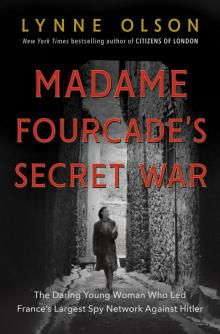 Madame Fourcade's Secret War
Madame Fourcade's Secret War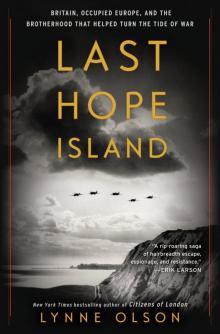 Last Hope Island
Last Hope Island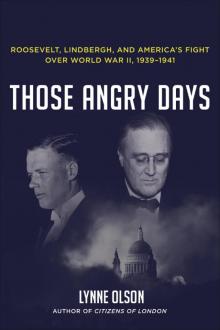 Those Angry Days
Those Angry Days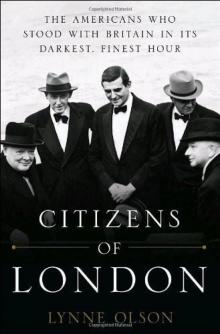 Citizens of London
Citizens of London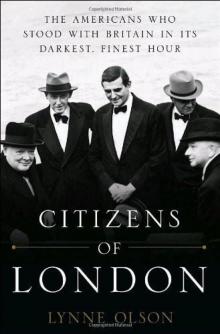 Citizens of London: The Americans Who Stood With Britain in Its Darkest, Finest Hour
Citizens of London: The Americans Who Stood With Britain in Its Darkest, Finest Hour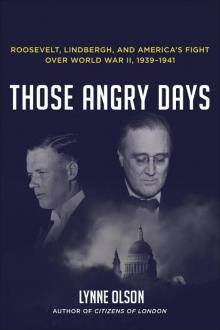 Those Angry Days: Roosevelt, Lindbergh, and America's Fight Over World War II, 1939-1941
Those Angry Days: Roosevelt, Lindbergh, and America's Fight Over World War II, 1939-1941